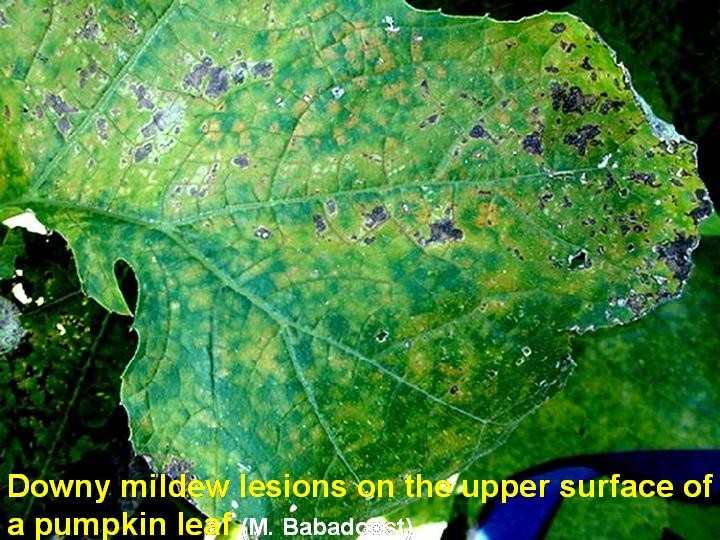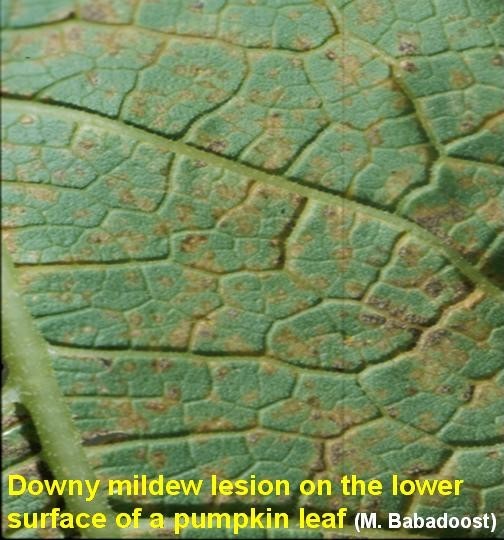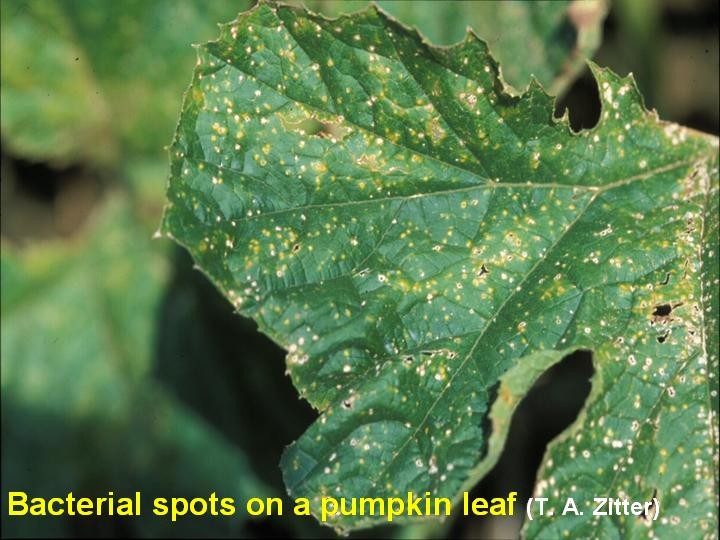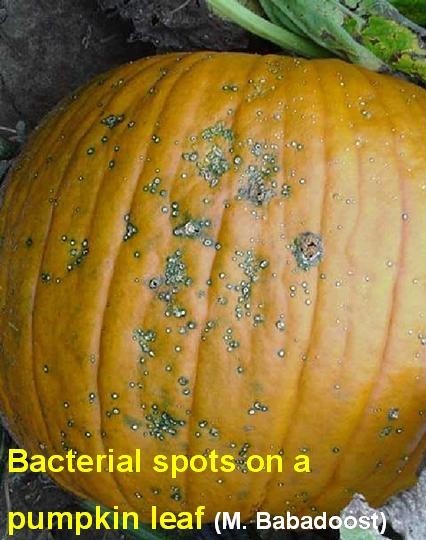2004 is a downy mildew year in Illinois.
This disease has been observed in almost all cucurbit fields throughout
Illinois. Downy mildew, caused by Pseudoperonospora cubensis, affects
all cucurbit crops.
Downy mildew only affects leaves. Symptoms of downy mildew vary with
the host and the environmental conditions. The first symptom is usually
the appearance of indistinct, pale green areas on the upper leaf surface.
The pale green areas soon become yellow in color and angular to irregular
in shape, bounded by the leaf veins. As the disease progress the lesions
may remain yellow or become brown and necrotic. During moist weather
the corresponding lower leaf surface is covered with a downy, pale gray
to purple mildew. On watermelons, yellow leaf spots may be angular or
non-angular, and they will later turn brown to black in color. Often
on watermelons, an upward leaf curling will occur.
Downy mildew pathogen survives only on cucurbit hosts. The pathogen
overwinters in the southern United States where cucurbits are grown
during winter. It progresses northward with cucurbit production each
spring. Usually by the time downy mildew becomes established in the
Midwest, it is toward the end of season for most of the cucurbit crops.
Once infection has taken place, the pathogen can produce spores (sporangia)
in about four days, which initiate another infection cycle. Downy mildew
is favored by cool, wet conditions.
Control of downy mildew on cucurbits is achieved by planting resistant
cultivars, early planting of crops, and/or fungicide sprays. Cucumber
cultivars resistant to downy mildew are available. Early plantings for
crops for July harvest often escape infection with downy mildew, while
plantings for harvest in August or later in the season are vulnerable.
Because of the potential for rapid plant infection, sprays should be
initiated on a preventive basis for vulnerable plantings. Fields should
be scouted regularly for disease development. When downy mildew is present,
fungicides should be applied. Fungicides with systemic activity tend
to be more effective than protectants. Using systemic fungicides with
protectants will minimize resistant development in the pathogen. Pristine,
Cabrio, Quadris, and Flint have been effective against downy mildew
in cucurbit fields. Pristine provided very good protection to pumpkin
plants against downy mildew in experimental plots. A disease- forecasting
program is available (www.ces.ncsu.edu/depts/pp/cucurbit).
2.
Bacterial Spot of Cucurbits
Bacterial spot, caused by the bacterium
Xanthomonas campestris pv. cucurbitae, has been observed in pumpkin
field throughout of Illinois. This is a serious disease of cucurbits.
The pathogen infects cucumbers, gourds, pumpkins, and summer and winter
squashes. Outbreaks of bacterial spot in Illinois, however, have been
observed only on pumpkin. Yield losses caused by this disease exceed
50% in the fields in moist conditions.
Symptoms on leaves appear as small (1-2 millimeters) and dark lesions,
with indefinite yellow margin. The lesions may coalesce to form larger
necrotic areas, usually on leaf margins. The most readily identifiable
symptoms occur on fruit. The appearance and size of fruit lesions can
vary, depending on rind maturity and the presence of moisture. Initial
lesions are small, slightly sunken, circular spots, 1/16 to 1/4 inch
in diameter, with a beige center and a dark- brown halo. Later the cuticle
and epidermis crack, and the lesions enlarge, reaching up to 1/2 inch
in diameter. The large lesions may have scab-like appearance and give
rise to tan, raised blisters. On mature fruit, saprophytic fungi often
colonize the dead, tan tissue at the center of the lesion. Penetration
of the bacteria into the flesh can lead to significant fruit rot in
the field or later in storage.
The bacterium
is a seed-borne pathogen. Also, the bacteria can survive in association
with infested crop residue. The disease appears during the summer months
when temperatures are high, and most commonly after heavy rain, dew,
or overhead irrigation. Fruit infection occurs through natural opening
in young, rapidly expanding fruit prior to the development of thick,
waxy cuticle. The bacteria are splash-spread in the field. Spread of
the bacteria within fields can be very rapid. Long distance dispersal
of the pathogen is by contaminated seed.
The most effective method for control
of the disease is planting pathogen-free seed. Rotation with noncucurbit
crops is effective in management of the disease. Application of copper
compounds during early formation and expansion of fruit may result in
substantial fewer symptomatic pumpkins. Copper spray, however, is ineffective
once an epidemic is underway. At this time, ripen fruit should be harvested
and stored at dry condition.







